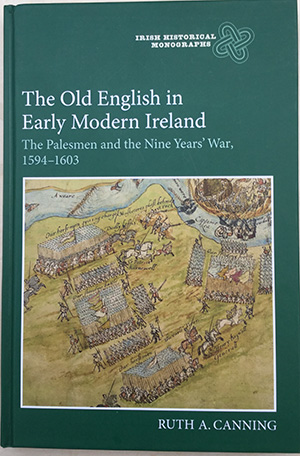THE OLD ENGLISH IN EARLY MODERN IRELAND: the Palesmen and the Nine Years’ War, 1594–1603
Published in Book Reviews, Book Reviews, Issue 2 (March/April 2020), Reviews, Volume 28RUTH A. CANNING
Boydell Press
£75
ISBN 9781783273270
Reviewed by Henry A. Jefferies
 Henry A. Jefferies is a research associate in history at Ulster University.
Henry A. Jefferies is a research associate in history at Ulster University.
Dr Canning uses the term ‘Old English’ explicitly to connote any descendants of English colonists who arrived in Ireland prior to 1541 (pp 2–3). She acknowledges that historians have ‘long quibbled’ over the use of the term ‘Old English’, but she defends it on the basis of its use by Edmund Spencer and one other individual during the Nine Years War. In fact, Spencer’s reference is to the ‘old’ or ‘ancient’ English settlers who came to Ireland, not to the ‘Old English’. The latter were a self-conscious and fairly cohesive community of Catholic political élites who came together in the first decades of the seventeenth century to defend their interests against British Protestant arrivistes in Ireland. By contrast, the Palesmen were, according to Canning herself, ‘a disorganised coalition of sometimes disparate interests’ who lacked ‘any sense of unity or concord … during the 1590s’ (p. 198). This is no quibbling matter!
The Old English begins with a characterisation of Christopher Nugent, baron of Delvin, as a loyal Palesman, representative of his community, who was arrested on ‘trumped up charges of treason’ (p. 11). Canning declares that ‘it is probably safe to assume that Delvin’s greatest crimes were his Irish birth and his attachment to the old faith’ (p. 2). That makes no sense, however, as most of the population could have been arrested on such grounds. In fact, the reason why Delvin was gaoled was that he had sent a contingent of 100 soldiers to join the Catholic confederates as they headed southwards to Kinsale in 1601. And he was not alone; Bishop Thomas Jones wrote a vivid description of the extraordinary manner in which O’Neill’s confederates were fêted by many of the Palesmen while en route to their rendezvous with the Spaniards, with food, aqua vitae and even wine! On the other hand, Jones was an Englishman and Canning observes that the ‘vast majority of source material utilised in this study comes directly from the pens of Englishmen … [which] lends itself to a biased interpretation of events and participants of this war’. Hence she read ‘between the lines’ in order to contradict the ‘unanimous official line’ that the local élites were of doubtful loyalty if not actually treacherous during the war (p. 197). Arguably, instead of contradicting ‘the vast majority of the source material utilised’ simply because it was penned by Englishmen, it would have been more useful to analyse the perspectives of the English officials who generated so much of the source material in order to help us understand better why they wrote what they did. A fundamental problem with The Old English is that it is too insular and would have benefited from a consideration of its subject within a broader Tudor or English dominions framework.
Canning states that there is ‘not conclusive proof that the entire lay and clerical population championed rebellion’, and that the Nine Years War did not enjoy ‘universal’ support. Yet no one ever made such outlandish claims: it is a straw man argument! A decade ago, in The Irish Church and the Tudor reformations, I highlighted, inter alia, two features of the Nine Years War: the role of Catholic clergymen in fostering and sustaining the war, and ‘the support it enjoyed (much of it tacit, but significant nonetheless) among a considerable number of lords, gentlemen and urban oligarchs of English descent’. ‘At the same time, I wish to make it very clear that I do not regard the Nine Years War simply as a religious war …’ (pp 259, 264–5). In many ways, Canning’s book confirms what I wrote then. In page after page she discusses the ‘many’ clerical conspirators who blessed the war and the fact that the religious dimension ‘transcended ethnic boundaries’ (p. 20), and she acknowledges the voluminous evidence of widespread support for O’Neill’s rebellion among the so-called ‘Old English’. Tellingly, it was Anglophone merchants who supplied the Catholic confederates with most of the modern weaponry they deployed against the English. On the other hand, there were other men of English descent in Ireland who fought for the queen. Canning declares that ‘There was nothing straightforward about the loyalties and behaviour of the Old English population’ (p. 77).
Canning concludes that it was not a ‘foregone conclusion’ that the leading Palesmen would remain loyal to Elizabeth because their ‘concerns about their declining political influence would probably have justified revolt in many eyes’ (p. 199). She asserts that ‘the vast majority were far more incensed over what they perceived to be English oppressions and infringements on their traditional privileges rather than the imposition of an alien religion’ (pp 48–9). That emphasis, however, is not reflective of the contemporary records. The question is, how far is it permissible for a historian to ‘read between the lines’ if source materials are considered ‘one-sided’ (p. 47) and ‘biased’ (p. 197) simply because they came from Englishmen?
















